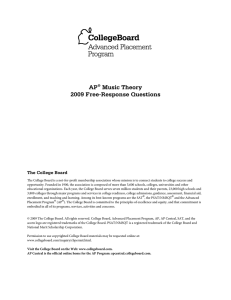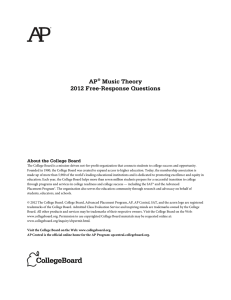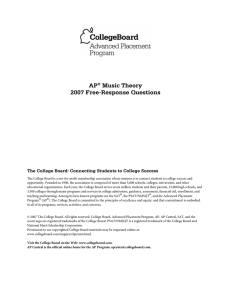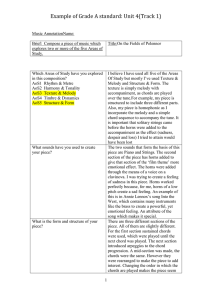AP Music Theory 2013 Free-Response Questions
advertisement
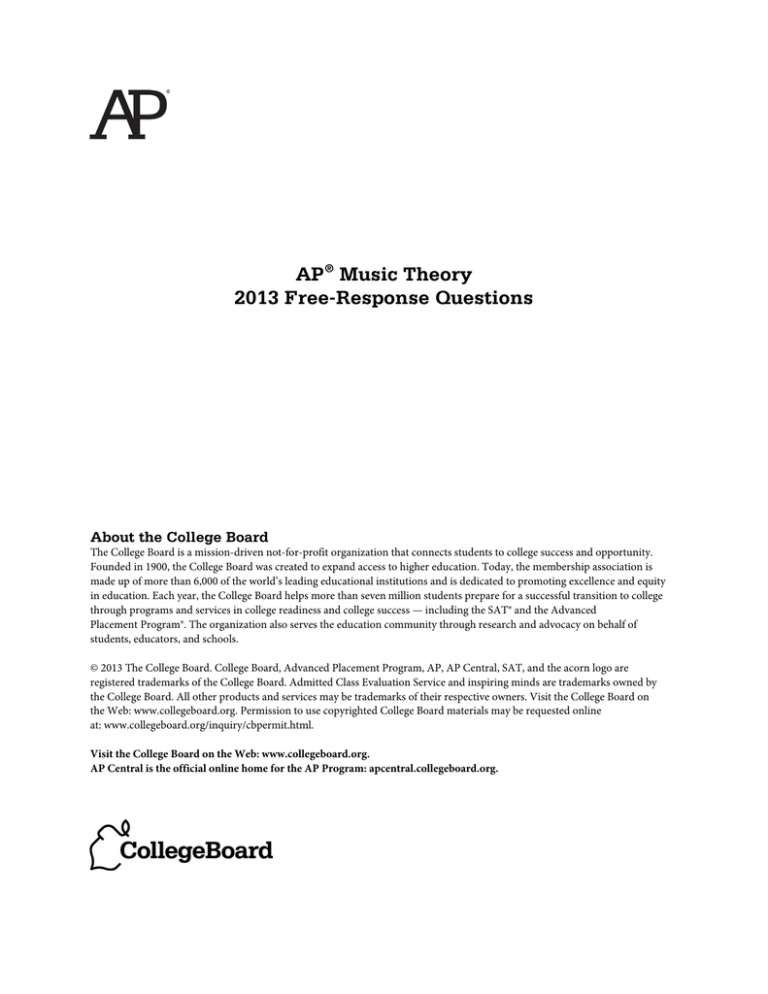
AP® Music Theory 2013 Free-Response Questions About the College Board The College Board is a mission-driven not-for-profit organization that connects students to college success and opportunity. Founded in 1900, the College Board was created to expand access to higher education. Today, the membership association is made up of more than 6,000 of the world’s leading educational institutions and is dedicated to promoting excellence and equity in education. Each year, the College Board helps more than seven million students prepare for a successful transition to college through programs and services in college readiness and college success — including the SAT® and the Advanced Placement Program®. The organization also serves the education community through research and advocacy on behalf of students, educators, and schools. © 2013 The College Board. College Board, Advanced Placement Program, AP, AP Central, SAT, and the acorn logo are registered trademarks of the College Board. Admitted Class Evaluation Service and inspiring minds are trademarks owned by the College Board. All other products and services may be trademarks of their respective owners. Visit the College Board on the Web: www.collegeboard.org. Permission to use copyrighted College Board materials may be requested online at: www.collegeboard.org/inquiry/cbpermit.html. Visit the College Board on the Web: www.collegeboard.org. AP Central is the official online home for the AP Program: apcentral.collegeboard.org. 2013 AP® MUSIC THEORY FREE-RESPONSE QUESTIONS SECTION II, Part A Music Theory Time— Approximately 68 minutes Answer questions 1-7 in the space provided. If you choose to use the facing pages of manuscript paper for scratch work, be sure to save time for writing your final answer in the staves provided directly below each question. If you need to rewrite your answer to any question, use the facing page of music manuscript paper and indicate on the page with the question that your answer is on the facing page. Questions 1-2 For each of these questions, you are to notate on the staves provided the correct pitch and rhythm of a short melody that you will hear. Make sure that any accidentals you use are appropriate for the key signature provided. In each case, the pulse will be established before the first playing of the melody. Question 1. The melody will be played three times. There will be a pause of 30 seconds after the first playing and a one-minute pause after each subsequent playing. The melody you will hear uses all four of the measures provided below and contains no rests. The melody will be played on a violin. The pitch of the first note has been provided. Be sure to notate the rhythm of that note. Now listen to the melody for the first time and begin to notate it. The melody for Question 1 will now be played a second time. The melody for Question 1 will now be played a final time. © 2013 The College Board. Visit the College Board on the Web: www.collegeboard.org. -2- 2013 AP® MUSIC THEORY FREE-RESPONSE QUESTIONS Question 2. The melody will be played four times. There will be a pause of 30 seconds after the first playing and a one-minute pause after each subsequent playing. The melody you will hear uses all four of the measures provided below and contains no rests. The melody will be played on a cello. The pitch of the first note has been provided. Be sure to notate the rhythm of that note. Now listen to the melody for the first time and begin to notate it. The melody for Question 2 will now be played a second time. The melody for Question 2 will now be played a third time. The melody for Question 2 will now be played a final time. PLEASE GO ON TO THE NEXT SET OF QUESTIONS. © 2013 The College Board. Visit the College Board on the Web: www.collegeboard.org. -3- 2013 AP® MUSIC THEORY FREE-RESPONSE QUESTIONS Questions 3-4 For each of these questions, you will hear a harmonic progression in four parts. In each case, the progression will be played four times. There will be a pause of 30 seconds after the first playing and a one-minute pause after each subsequent playing. For each question, please do the following. (a) Notate only the soprano and bass voices. Do not notate the alto and tenor voices. (b) On the blanks provided under each staff, write in the Roman and Arabic numerals that indicate the chords and their inversions. (c) Make sure to align your notes with the blanks provided. Question 3. Before listening to the first playing, please look at the staff below. Notice that there are nine chords in the progression; the soprano and bass notes and the Roman numeral of the first chord are given. Now listen to the progression for the first time and begin working. The progression for Question 3 will now be played a second time. The progression for Question 3 will now be played a third time. The progression for Question 3 will now be played a final time. © 2013 The College Board. Visit the College Board on the Web: www.collegeboard.org. -4- 2013 AP® MUSIC THEORY FREE-RESPONSE QUESTIONS Question 4. Before listening to the first playing, please look at the staff below. Notice that there are nine chords in the progression; the soprano and bass notes and the Roman numeral of the first chord are given. Remember to notate only the soprano and bass voices and to provide the numerals indicating the chords and their inversions. Now listen to the progression for the first time and begin working. The progression for Question 4 will now be played a second time. The progression for Question 4 will now be played a third time. The progression for Question 4 will now be played a final time. The remaining free-response questions for the music theory test are without aural stimulus. You may answer them in the order you choose. You have a total of 45 minutes to complete free-response questions 5-7. A suggested time for each question is printed in your test booklet. Read the three questions carefully and use your time effectively. Now turn the page and begin work. © 2013 The College Board. Visit the College Board on the Web: www.collegeboard.org. -5- 2013 AP® MUSIC THEORY FREE-RESPONSE QUESTIONS Question 5. (Suggested time—15 minutes) Realize the figured bass below in four voices, following traditional eighteenth-century voice-leading procedures. Continue logically from the spacing of the first chord. Do not add embellishments unless indicated by the figured bass. In the space below each chord, supply the Roman numeral that appropriately indicates harmonic function. © 2013 The College Board. Visit the College Board on the Web: www.collegeboard.org. -6- 2013 AP® MUSIC THEORY FREE-RESPONSE QUESTIONS Question 6. (Suggested time—10 minutes) Write the following progression in four voices, following eighteenth-century voice-leading procedures. Continue logically from the spacing of the first chord. Do not add embellishments unless indicated by the Roman and Arabic numerals. Use only quarter and half notes. © 2013 The College Board. Visit the College Board on the Web: www.collegeboard.org. -7- 2013 AP® MUSIC THEORY FREE-RESPONSE QUESTIONS Question 7. (Suggested time—20 minutes) Complete the bass line for the melody below, following eighteenth-century voice-leading procedures. Place Roman numerals with inversion symbols below the bass line to indicate the harmonies implied by the soprano and bass. Observe the following: A. Keep the portion you compose consistent with the first phrase. 1. Use an appropriate cadence at each phrase ending. 2. Give melodic interest to the bass line. 3. Vary the motion of the bass line in relation to the soprano. 4. Use mostly quarter notes, but you may use note values ranging from half notes to eighth notes. B. Do not notate alto and tenor lines. STOP END OF WRITTEN EXAM © 2013 The College Board. Visit the College Board on the Web: www.collegeboard.org. -8-
